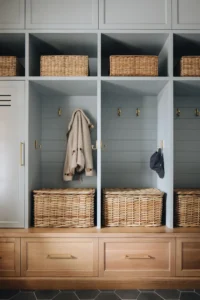The design-build process has become a popular choice for homeowners looking to renovate their homes efficiently and seamlessly. It provides a streamlined approach by integrating both the design and construction phases under one contract. This allows for better communication, collaboration, and a smoother experience overall. If you’re planning a home renovation, understanding how the design-build process works is essential for ensuring your project runs smoothly from start to finish.
What is the Design-Build Process?
The design-build process combines the responsibilities of designing and constructing your project into a single contract. In a traditional home renovation, you would hire an architect or designer separately from a contractor, which often leads to communication gaps or project delays. With design-build, the team working on your project includes both designers and builders from the beginning. This results in a more collaborative approach, reducing misunderstandings and inefficiencies during the renovation.
A key benefit of the design-build process is that it promotes teamwork between the client, designers, and builders. All parties work together to create a cohesive plan that aligns with your vision and budget. By having one point of contact for the entire project, you’ll experience fewer delays, and decision-making becomes faster. Additionally, because the design and construction phases are closely integrated, there is greater flexibility to adjust the project as it progresses without major disruptions.
How to Plan a Home Renovation
When planning a home renovation, it’s crucial to start with a clear vision of what you want to achieve. Begin by assessing your home’s current condition and identifying areas that need improvement or could be optimized. Prioritize your renovation goals—whether it’s improving functionality, increasing space, or modernizing the aesthetic of your home. Once you have a clear idea, it’s time to establish a budget that reflects your priorities and scope.
Next, decide whether you want to follow the traditional method or opt for the design-build process. If you value streamlined communication and a unified approach, the design-build option may be ideal. Before the renovation begins, make sure to create a realistic timeline that factors in the scope of work and any potential delays. Working with an experienced design-build team can help you plan effectively and manage the entire process from design to completion.
Planning ahead and setting clear expectations with your team is essential to staying on track. The more organized your renovation plan is, the easier it will be to make informed decisions and avoid costly surprises during construction.
Benefits of the Design-Build Process
One of the main advantages of the design-build process is its efficiency. With one team handling both design and construction, the project timeline is often shorter. This is because the contractor and designer work together from the outset, which helps reduce back-and-forth communication delays. Additionally, this collaboration minimizes the risk of design changes mid-project, leading to a more efficient use of time and resources.
Cost savings are another significant benefit. When the design and construction teams collaborate closely, the project stays within budget more easily. The design-build process allows for greater cost transparency from the start, giving you a better understanding of where your money is being spent. This prevents budget overruns, as both the design and construction phases are coordinated to avoid unexpected changes or delays.
The design-build process also allows for more innovation and creativity. Because the team is integrated, it can offer more solutions for design challenges and present options that may not have been considered in a traditional approach. This flexibility allows you to achieve the best possible outcome while staying within budget.
Current Home Renovation Trends to Consider
When planning a renovation, it’s important to stay up-to-date on current home renovation trends. Incorporating modern design ideas can increase the functionality and aesthetic appeal of your home. One trend in particular is the focus on energy efficiency and sustainability. Many homeowners are opting for energy-efficient materials, windows, and insulation that lower utility costs while reducing environmental impact.
Another popular trend is open-concept living spaces. This design choice removes unnecessary walls, creating larger, more versatile areas for family activities and entertaining. Open layouts are especially popular in kitchen and living room renovations, where the goal is to create a space that feels connected and welcoming. Incorporating smart home technology is also a growing trend, allowing homeowners to control lighting, security, and heating systems with just a few taps on their phone.
Many homeowners are focusing on creating multifunctional spaces. With more people working from home, areas like basements, garages, or spare rooms are being transformed into home offices or personal gyms. By following these trends, your renovation can meet both current needs and long-term goals, making your home more adaptable and valuable.
Managing the Design-Build Process
Successfully managing the design-build process requires clear communication and collaboration between you and your renovation team. Start by working closely with your design-build team to outline your goals and establish realistic timelines. Early discussions should focus on your overall vision, including layout preferences, materials, and design features you want to incorporate into the renovation.
Throughout the design-build process, it’s essential to stay involved and communicate any concerns or questions as they arise. Regular meetings with your design-build team will ensure that everyone remains aligned and that any necessary adjustments are made promptly. Additionally, ensure that the project stays on budget by reviewing cost estimates at key project milestones. Staying informed and flexible will help the process run smoothly and minimize unexpected issues.
Effective project management also involves keeping the design-build team accountable. Monitor progress, and ask for updates on any obstacles or potential delays. Maintaining open lines of communication will help prevent miscommunications and ensure that the project meets your expectations.
Choosing the Right Design-Build Firm
Selecting the right design-build firm is one of the most critical decisions you’ll make during a home renovation. Look for a firm with a strong portfolio that aligns with your vision, and make sure they have experience with projects similar to yours. It’s also important to check customer reviews and testimonials to gauge how satisfied previous clients were with their results.
Communication is key when working with a design-build firm. Choose a team that prioritizes transparent communication and is willing to work closely with you throughout the project. A design-build team that listens to your ideas, offers suggestions, and provides regular updates is essential for ensuring your project’s success.
Make sure the firm you choose is licensed and insured. This not only protects you as a homeowner but also ensures that your project will meet local building codes and regulations. A trustworthy design-build firm will guide you through the process while keeping your budget, schedule, and vision at the forefront.
Common Challenges and How to Overcome Them
Even with the design-build process, home renovations can come with challenges. One common issue is budget overruns. To avoid this, work closely with your design-build team to set a clear budget upfront, and ensure that any changes are discussed in advance. Unexpected expenses can still arise, but a transparent budgeting process will help minimize their impact.
Another challenge is project delays, which can occur due to materials shortages, weather conditions, or unforeseen structural issues. To mitigate these risks, plan for flexibility in your project timeline. Working with an experienced design-build team can also help anticipate potential problems and address them early.
Decision fatigue is a challenge many homeowners face during renovations. With so many design choices, it can feel overwhelming to make every decision. To overcome this, trust your design-build team to offer guidance and recommendations that align with your vision. Focus on the big-picture goals of your renovation, and rely on professionals for smaller details.
For more helpful tips or if you have any questions, feel free to contact us at (617) 480–6836 or visit https://homeadditionma.com for more






